Mapping Urban Expansions along China–Europe Railway Express with the 30 m Time-Series Global Impervious Surface Area (GISA-2) Data from 2010 to 2019
Abstract
:1. Introduction
2. Materials and Methods
2.1. Study Area
2.2. Data
2.2.1. Global Impervious Surface Area (GISA 2)
2.2.2. CRE Outline Data and Other Ancillary Data
2.3. Methodology
- (1)
- Initial boundary extraction: aggregation of ISA to delineate prospective urban fringes through a kernel density estimator;
- (2)
- Boundary improvement: multiscale fusion applied to refine the initial urban boundaries, which distinctively diverges from Li’s foundational framework [34] by offering an explicit spatial enhancement for cities of different scales;
- (3)
- Post-processing: measures designed to rectify minor discontinuities (e.g., small water bodies and green spaces) within the urban fabric and to ensure the temporal coherence of the urban expansion patterns.
2.3.1. Urban Fringe and Initial Boundary Extraction
2.3.2. Boundary Improvement with Multiscale Fusion
3. Results
3.1. Evaluations of Derived Urban Boundaries
3.1.1. Comparison with Historical Google Imagery
3.1.2. Cross-Comparisons with Other Global 30 m Urban Products
3.2. The Spatiotemporal Dynamics of Urban Boundaies from 2010 to 2019
3.2.1. Spatiotemporal Patterns Urban Clusters
3.2.2. Comparison of Spatial Dynamics between ON-CRE and OFF-CRE Cities
4. Discussion
5. Conclusions
Author Contributions
Funding
Institutional Review Board Statement
Informed Consent Statement
Data Availability Statement
Conflicts of Interest
References
- Gong, J.; Liu, C.; Huang, X. Advances in urban information extraction from high-resolution remote sensing imagery. Sci. China Earth Sci. 2020, 63, 463–475. [Google Scholar] [CrossRef]
- Liu, Y.; Ou, C.; Li, Y.; Zhang, L.; He, J. Regularity of rural settlement changes driven by rapid urbanization in North China over the three decades. Sci. Bull. 2023, 68, 2115–2124. [Google Scholar] [CrossRef]
- Song, Y.; Chen, B.; Kwan, M.-P. How does urban expansion impact people’s exposure to green environments? A comparative study of 290 Chinese cities. J. Clean. Prod. 2020, 246, 119018. [Google Scholar] [CrossRef]
- Hafeez, M.; Yuan, C.; Shah, W.U.H.; Mahmood, M.T.; Li, X.; Iqbal, K. Evaluating the relationship among agriculture, energy demand, finance and environmental degradation in one belt and one road economies. Carbon Manag. 2020, 11, 139–154. [Google Scholar] [CrossRef]
- Liu, H.; Gu, W.; Liu, W.; Wang, J. The influence of China-Europe Railway Express on the production system of enterprises: A case study of TCL Poland Plant. J. Geogr. Sci. 2021, 31, 699–711. [Google Scholar] [CrossRef]
- Wu, Q.; Madni, G.R. Environmental protection in selected one belt one road economies through institutional quality: Prospering transportation and industrialization. PLoS ONE 2021, 16, e0240851. [Google Scholar] [CrossRef] [PubMed]
- Zhai, W. Risk assessment of China’s foreign direct investment in “One Belt, One Road”: Taking the green finance as a research perspective. Socio-Econ. Plan. Sci. 2023, 87, 101558. [Google Scholar] [CrossRef]
- Zhao, M.; Zhou, Y.; Li, X.; Cheng, W.; Zhou, C.; Ma, T.; Li, M.; Huang, K. Mapping urban dynamics (1992–2018) in Southeast Asia using consistent nighttime light data from DMSP and VIIRS. Remote Sens. Environ. 2020, 248, 111980. [Google Scholar] [CrossRef]
- Shao, Z.; Liu, C. The Integrated Use of DMSP-OLS Nighttime Light and MODIS Data for Monitoring Large-Scale Impervious Surface Dynamics: A Case Study in the Yangtze River Delta. Remote Sens. 2014, 6, 9359–9378. [Google Scholar] [CrossRef]
- Chen, Z.; Yu, B.; Song, W.; Liu, H.; Wu, Q.; Shi, K.; Wu, J. A New Approach for Detecting Urban Centers and Their Spatial Structure With Nighttime Light Remote Sensing. IEEE Trans. Geosci. Remote Sens. 2017, 55, 6305–6319. [Google Scholar] [CrossRef]
- Zhuo, L.; Zheng, J.; Zhang, X.; Li, J.; Liu, L. An improved method of night-time light saturation reduction based on EVI. Int. J. Remote Sens. 2015, 36, 4114–4130. [Google Scholar] [CrossRef]
- Arnold, C.L., Jr.; Gibbons, C.J. Impervious Surface Coverage: The Emergence of a Key Environmental Indicator. J. Am. Plan. Assoc. 1996, 62, 243–258. [Google Scholar] [CrossRef]
- Gutiérrez-Rial, D.; Soto González, B.; García Vázquez, D.; Méndez-Martínez, G.; Pombal Diego, M.Á.; Garrido González, J. Freshwater biodiversity loss in urbanised rivers. Ecol. Indic. 2023, 156, 111150. [Google Scholar] [CrossRef]
- Hanh Nguyen, H.; Venohr, M.; Gericke, A.; Sundermann, A.; Welti, E.A.R.; Haase, P. Dynamics in impervious urban and non-urban areas and their effects on run-off, nutrient emissions, and macroinvertebrate communities. Landsc. Urban Plan. 2023, 231, 104639. [Google Scholar] [CrossRef]
- Oswald, C.J.; Kelleher, C.; Ledford, S.H.; Hopkins, K.G.; Sytsma, A.; Tetzlaff, D.; Toran, L.; Voter, C. Integrating urban water fluxes and moving beyond impervious surface cover: A review. J. Hydrol. 2023, 618, 129188. [Google Scholar] [CrossRef]
- García, D.H.; Díaz, J.A. Space–time analysis of the earth’s surface temperature, surface urban heat island and urban hotspot: Relationships with variation of the thermal field in Andalusia (Spain). Urban Ecosyst. 2023, 26, 525–546. [Google Scholar] [CrossRef]
- Li, L.; Zhan, W.; Hu, L.; Chakraborty, T.C.; Wang, Z.; Fu, P.; Wang, D.; Liao, W.; Huang, F.; Fu, H.; et al. Divergent urbanization-induced impacts on global surface urban heat island trends since 1980s. Remote Sens. Environ. 2023, 295, 113650. [Google Scholar] [CrossRef]
- Li, C.; Yang, J.; Zhang, Y. Evaluation and Analysis of the Impact of Coastal Urban Impervious Surfaces on Ecological Environments. IEEE J. Sel. Top. Appl. Earth Obs. Remote Sens. 2023, 16, 8721–8733. [Google Scholar] [CrossRef]
- Wang, Y.; Li, M. Urban Impervious Surface Detection from Remote Sensing Images: A review of the methods and challenges. IEEE Geosci. Remote Sens. Mag. 2019, 7, 64–93. [Google Scholar] [CrossRef]
- Xie, Y.; Weng, Q. Spatiotemporally enhancing time-series DMSP/OLS nighttime light imagery for assessing large-scale urban dynamics. ISPRS J. Photogramm. Remote Sens. 2017, 128, 1–15. [Google Scholar] [CrossRef]
- Gong, P.; Li, X.; Wang, J.; Bai, Y.; Chen, B.; Hu, T.; Liu, X.; Xu, B.; Yang, J.; Zhang, W.; et al. Annual maps of global artificial impervious area (GAIA) between 1985 and 2018. Remote Sens. Environ. 2020, 236, 111510. [Google Scholar] [CrossRef]
- Liu, X.; Huang, Y.; Xu, X.; Li, X.; Li, X.; Ciais, P.; Lin, P.; Gong, K.; Ziegler, A.D.; Chen, A.; et al. High-spatiotemporal-resolution mapping of global urban change from 1985 to 2015. Nat. Sustain. 2020, 3, 564–570. [Google Scholar] [CrossRef]
- Huang, X.; Li, J.; Yang, J.; Zhang, Z.; Li, D.; Liu, X. 30 m global impervious surface area dynamics and urban expansion pattern observed by Landsat satellites: From 1972 to 2019. Sci. China Earth Sci. 2021, 64, 1922–1933. [Google Scholar] [CrossRef]
- Melchiorri, M.; Florczyk, A.J.; Freire, S.; Schiavina, M.; Pesaresi, M.; Kemper, T. Unveiling 25 Years of Planetary Urbanization with Remote Sensing: Perspectives from the Global Human Settlement Layer. Remote Sens. 2018, 10, 768. [Google Scholar] [CrossRef]
- Shao, Z.; Cheng, T.; Fu, H.; Li, D.; Huang, X. Emerging Issues in Mapping Urban Impervious Surfaces Using High-Resolution Remote Sensing Images. Remote Sens. 2023, 15, 2562. [Google Scholar] [CrossRef]
- Melchiorri, M.; Pesaresi, M.; Florczyk, A.J.; Corbane, C.; Kemper, T. Principles and Applications of the Global Human Settlement Layer as Baseline for the Land Use Efficiency Indicator—SDG 11.3.1. ISPRS Int. J. Geo-Inf. 2019, 8, 96. [Google Scholar] [CrossRef]
- Huang, X.; Song, Y.; Yang, J.; Wang, W.; Ren, H.; Dong, M.; Feng, Y.; Yin, H.; Li, J. Toward accurate mapping of 30-m time-series global impervious surface area (GISA). Int. J. Appl. Earth Obs. Geoinf. 2022, 109, 102787. [Google Scholar] [CrossRef]
- Ren, H.; Liu, Y.; Chang, X.; Yang, J.; Xiao, X.; Huang, X. Mapping High-Resolution Global Impervious Surface Area: Status and Trends. IEEE J. Sel. Top. Appl. Earth Obs. Remote Sens. 2022, 15, 7288–7307. [Google Scholar] [CrossRef]
- Liang, X.; Guan, Q.; Clarke, K.C.; Liu, S.; Wang, B.; Yao, Y. Understanding the drivers of sustainable land expansion using a patch-generating land use simulation (PLUS) model: A case study in Wuhan, China. Comput. Environ. Urban Syst. 2021, 85, 101569. [Google Scholar] [CrossRef]
- Sun, Z.; Du, W.; Jiang, H.; Weng, Q.; Guo, H.; Han, Y.; Xing, Q.; Ma, Y. Global 10-m impervious surface area mapping: A big earth data based extraction and updating approach. Int. J. Appl. Earth Obs. Geoinf. 2022, 109, 102800. [Google Scholar] [CrossRef]
- Wang, Y.; Ziv, G.; Adami, M.; Mitchard, E.; Batterman, S.A.; Buermann, W.; Schwantes Marimon, B.; Marimon Junior, B.H.; Matias Reis, S.; Rodrigues, D.; et al. Mapping tropical disturbed forests using multi-decadal 30 m optical satellite imagery. Remote Sens. Environ. 2019, 221, 474–488. [Google Scholar] [CrossRef]
- Li, X.; Gong, P.; Zhou, Y.; Wang, J.; Bai, Y.; Chen, B.; Hu, T.; Xiao, Y.; Xu, B.; Yang, J.; et al. Mapping global urban boundaries from the global artificial impervious area (GAIA) data. Environ. Res. Lett. 2020, 15, 094044. [Google Scholar] [CrossRef]
- Worldmeter. Available online: https://www.worldometers.info/population/countries-in-europe-by-population/ (accessed on 16 July 2023).
- Althouse, J.; Cahen-Fourot, L.; Carballa-Smichowski, B.; Durand, C.; Knauss, S. Ecologically unequal exchange and uneven development patterns along global value chains. World Dev. 2023, 170, 106308. [Google Scholar] [CrossRef]
- Heiskanen, E.; Matschoss, K. Understanding the uneven diffusion of building-scale renewable energy systems: A review of household, local and country level factors in diverse European countries. Renew. Sustain. Energy Rev. 2017, 75, 580–591. [Google Scholar] [CrossRef]
- National Development and Reform Commission (NDRC) People’s Republic of China. Available online: https://www.ndrc.gov.cn/xwdt/xwfb/202208/t20220818_1333176.html (accessed on 18 August 2022).
- Gong, P.; Liu, H.; Zhang, M.; Li, C.; Wang, J.; Huang, H.; Clinton, N.E.; Ji, L.; Li, W.; Bai, Y.; et al. Stable classification with limited sample: Transferring a 30-m resolution sample set collected in 2015 to mapping 10-m resolution global land cover in 2017. Sci. Bull. 2019, 64, 370–373. [Google Scholar] [CrossRef] [PubMed]
- Zhao, M.; Zhou, Y.; Li, X.; Zhou, C.; Cheng, W.; Li, M.; Huang, K. Building a Series of Consistent Night-Time Light Data (1992–2018) in Southeast Asia by Integrating DMSP-OLS and NPP-VIIRS. IEEE Trans. Geosci. Remote Sens. 2020, 58, 1843–1856. [Google Scholar] [CrossRef]
- Homer, C.; Dewitz, J.; Yang, L.; Jin, S.; Danielson, P.; Xian, G.; Coulston, J.; Herold, N.; Wickham, J.; Megown, K. Completion of the 2011 National Land Cover Database for the Conterminous United States—Representing a Decade of Land Cover Change Information. Photogramm. Eng. Remote Sens. 2015, 81, 345–354. [Google Scholar]
- Li, X.; Zhou, Y.; Hejazi, M.; Wise, M.; Vernon, C.; Iyer, G.; Chen, W. Global urban growth between 1870 and 2100 from integrated high resolution mapped data and urban dynamic modeling. Commun. Earth Environ. 2021, 2, 201. [Google Scholar] [CrossRef]
- Kocabas, V.; Dragicevic, S. Assessing cellular automata model behaviour using a sensitivity analysis approach. Comput. Environ. Urban Syst. 2006, 30, 921–953. [Google Scholar] [CrossRef]
- Benediktsson, J.A.; Palmason, J.A.; Sveinsson, J.R. Classification of hyperspectral data from urban areas based on extended morphological profiles. IEEE Trans. Geosci. Remote Sens. 2005, 43, 480–491. [Google Scholar] [CrossRef]
- Luo, B.; Zhang, L. Robust Autodual Morphological Profiles for the Classification of High-Resolution Satellite Images. IEEE Trans. Geosci. Remote Sens. 2014, 52, 1451–1462. [Google Scholar] [CrossRef]
- Zhou, Y.; Li, X.; Asrar, G.R.; Smith, S.J.; Imhoff, M. A global record of annual urban dynamics (1992–2013) from nighttime lights. Remote Sens. Environ. 2018, 219, 206–220. [Google Scholar] [CrossRef]
- Zhang, X.; Liu, L.; Zhao, T.; Gao, Y.; Chen, X.; Mi, J. GISD30: Global 30-m impervious surface dynamic dataset from 1985 to 2020 using time-series Landsat imagery on the Google Earth Engine platform. Sci. China Earth Sci. 2021, 14, 1831–1856. [Google Scholar] [CrossRef]
- Dong, T.; Jiao, L.; Xu, G.; Yang, L.; Liu, J. Towards sustainability? Analyzing changing urban form patterns in the United States, Europe, and China. Sci. Total Environ. 2019, 671, 632–643. [Google Scholar] [CrossRef] [PubMed]
- Glaeser, E.L.; Kohlhase, J.E. Cities, regions and the decline of transport costs. Pap. Reg. Sci. 2004, 83, 197–228. [Google Scholar] [CrossRef]
- Nickayin, S.S.; Tomao, A.; Quaranta, G.; Salvati, L.; Gimenez Morera, A. Going toward Resilience? Town Planning, Peri-Urban Landscapes, and the Expansion of Athens, Greece. Sustainability 2020, 12, 10471. [Google Scholar] [CrossRef]
- Rae, A. English urban policy and the return to the city: A decade of growth, 2001–2011. Cities 2013, 32, 94–101. [Google Scholar] [CrossRef]
- Rubiera Morollón, F.; González Marroquin, V.M.; Pérez Rivero, J.L. Urban sprawl in Spain: Differences among cities and causes. Eur. Plan. Stud. 2016, 24, 207–226. [Google Scholar] [CrossRef]
- Martínez, A.; Martín, X.; Gordon, J. Matrix of Architectural Solutions for the Conflict between Transport Infrastructures, Landscape and Urban Habitat along the Mediterranean Coastline: The Case of the Maresme Region in Barcelona, Spain. Int. J. Environ. Res. Public Health 2021, 18, 9750. [Google Scholar] [CrossRef]
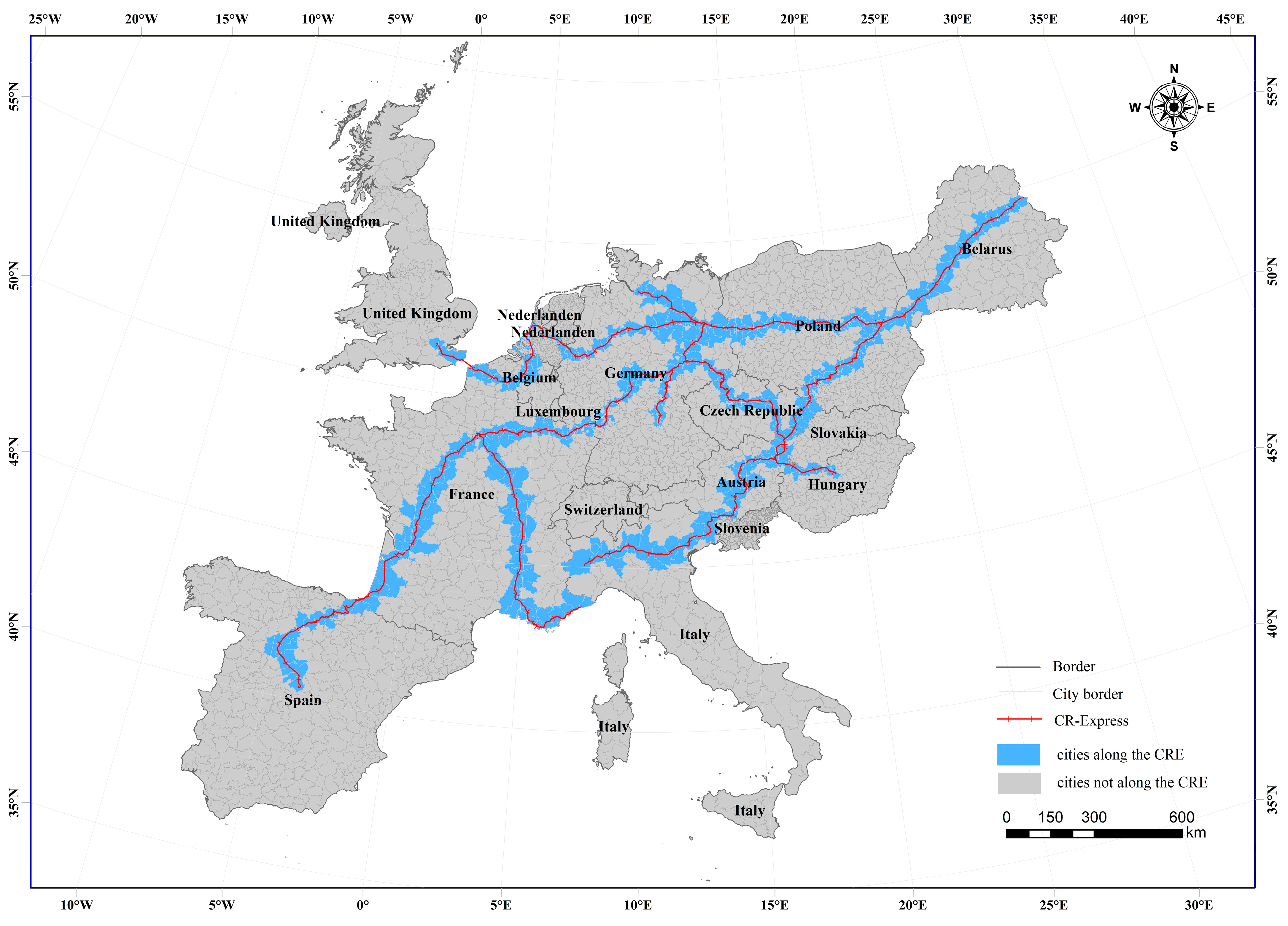
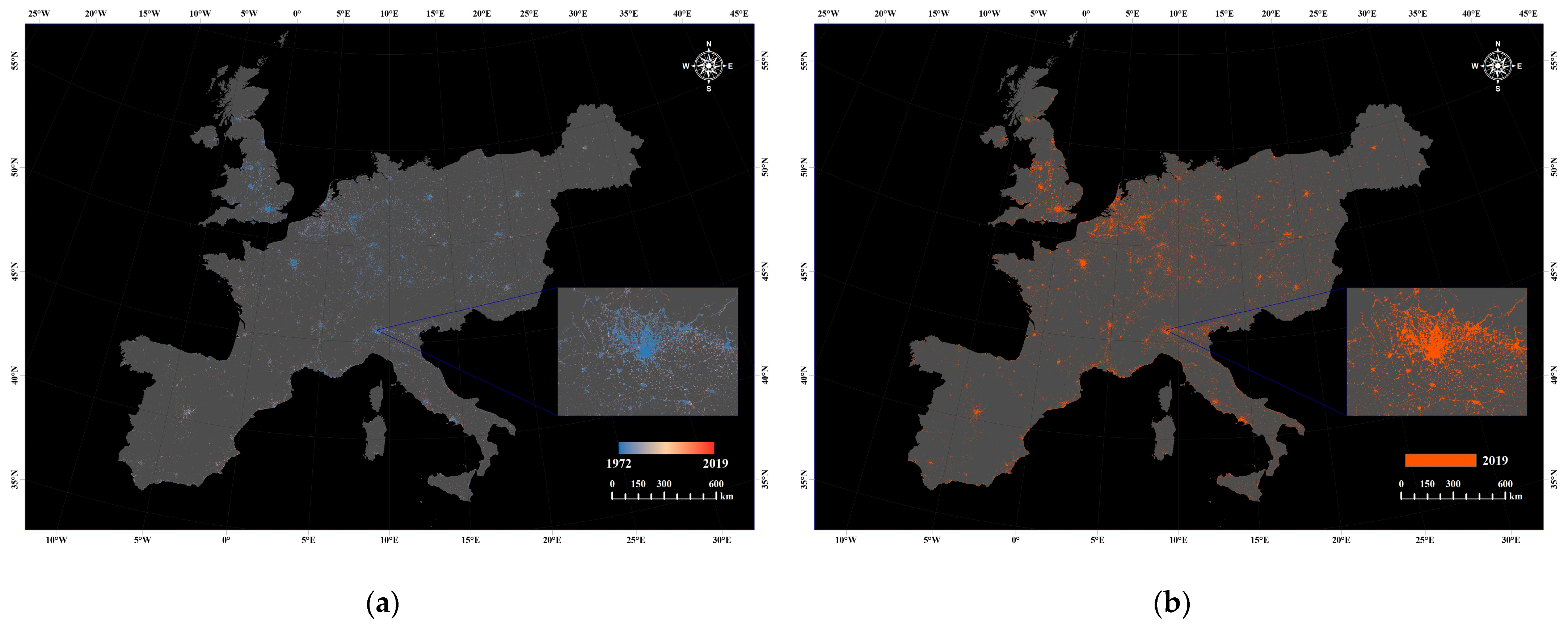
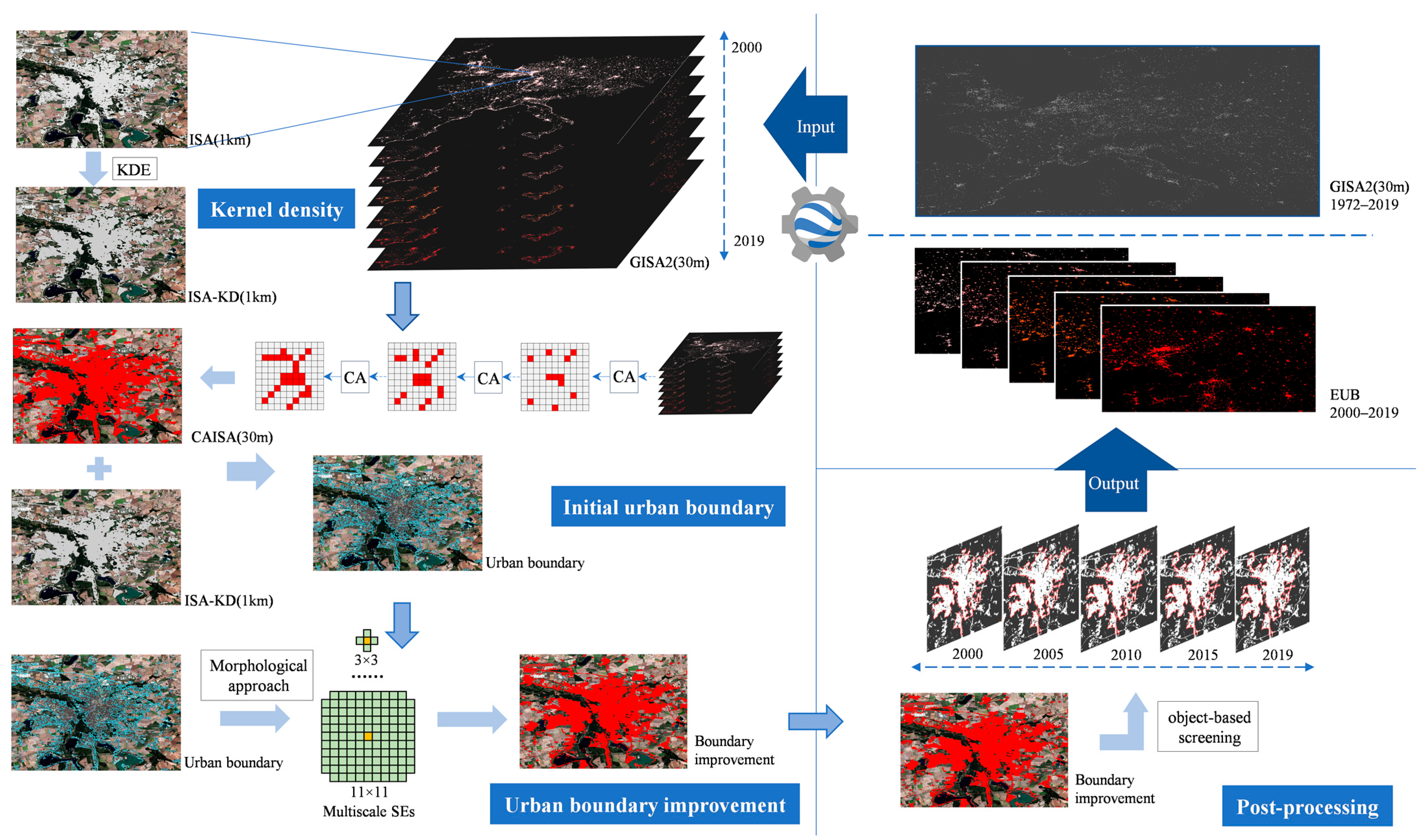
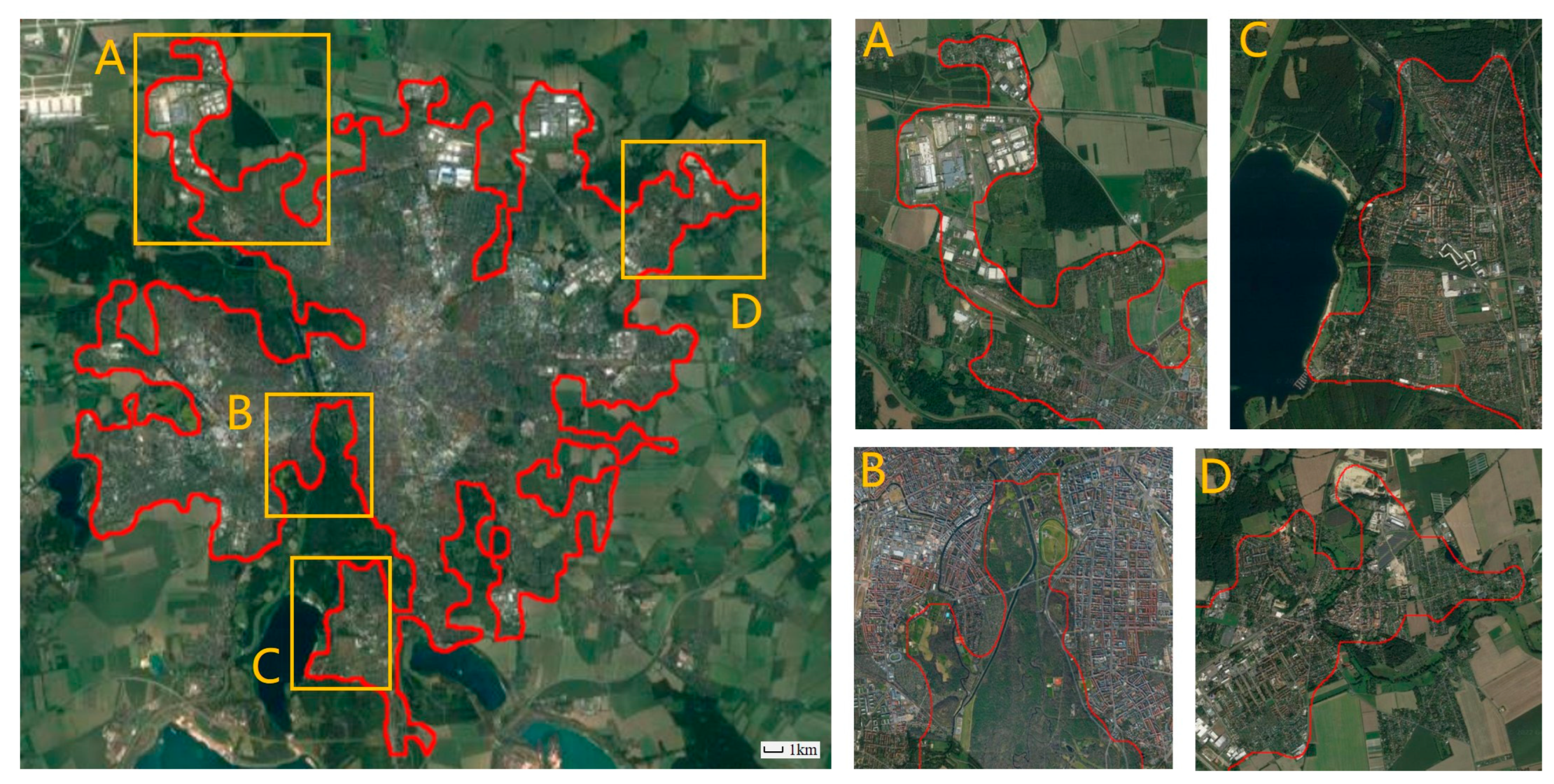
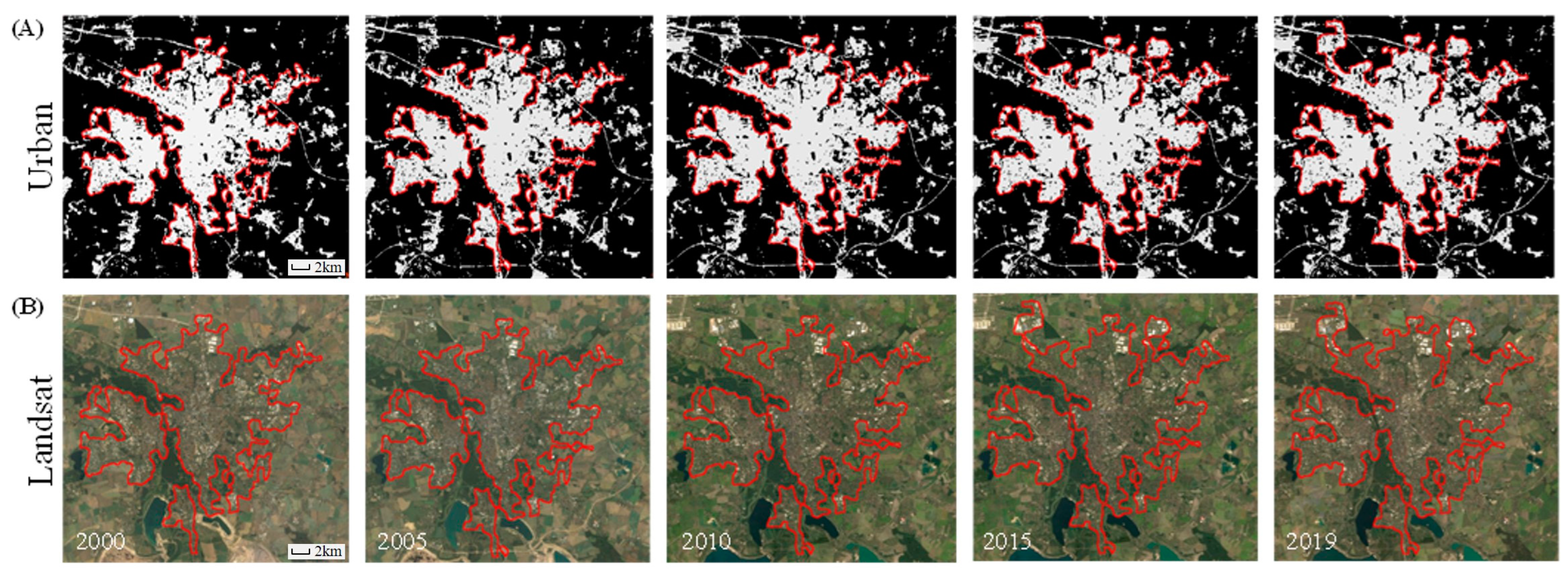
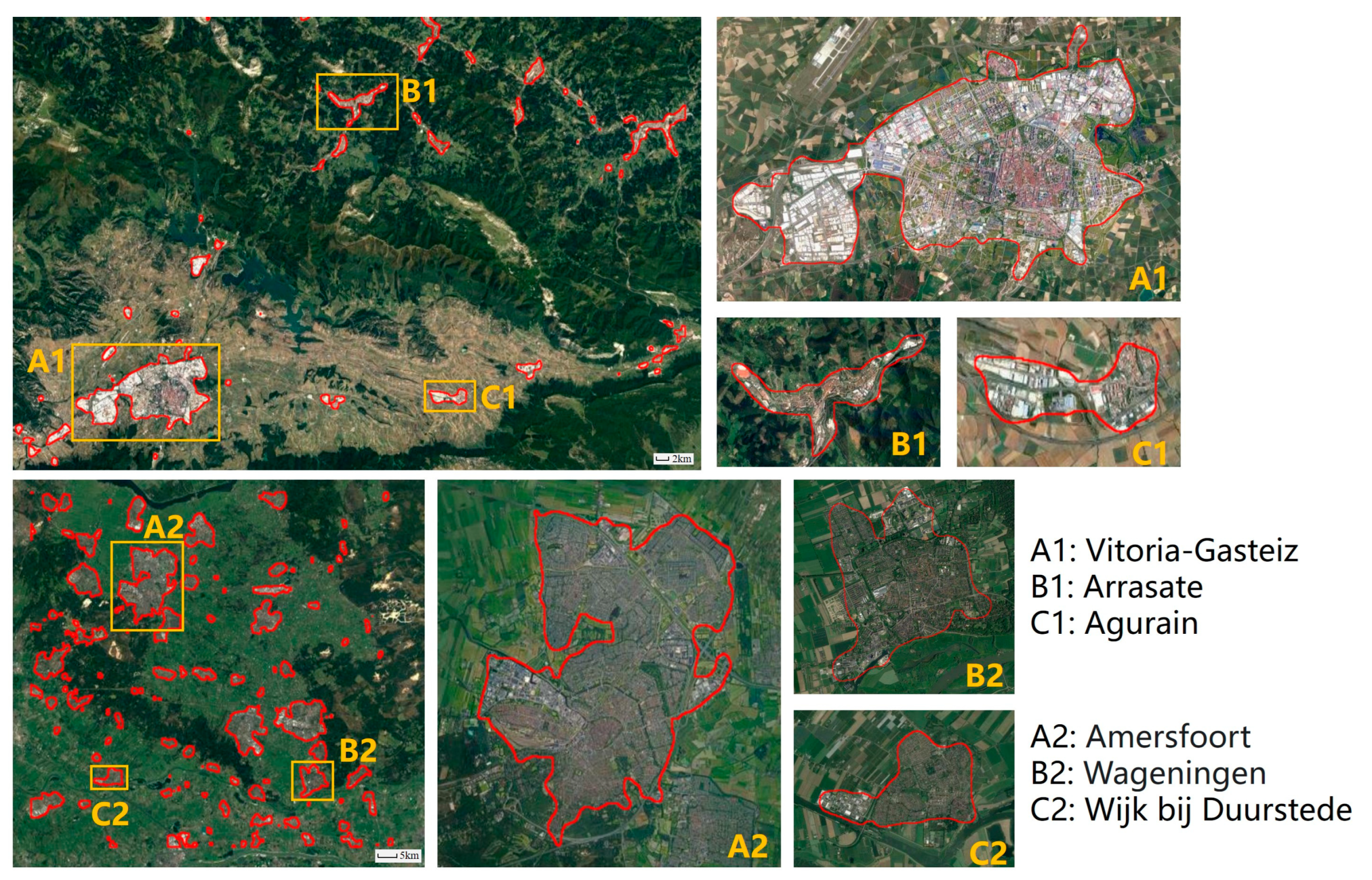


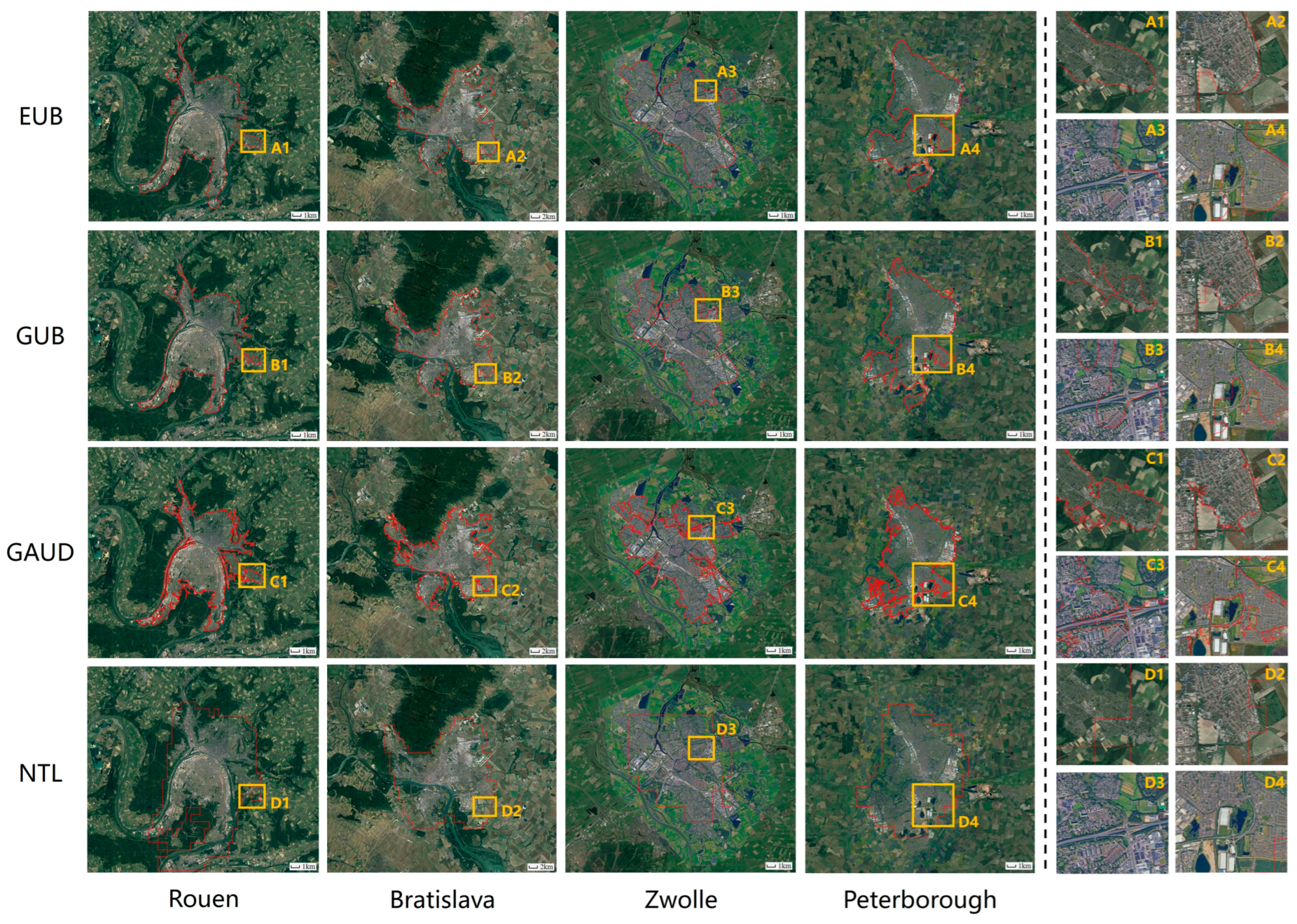
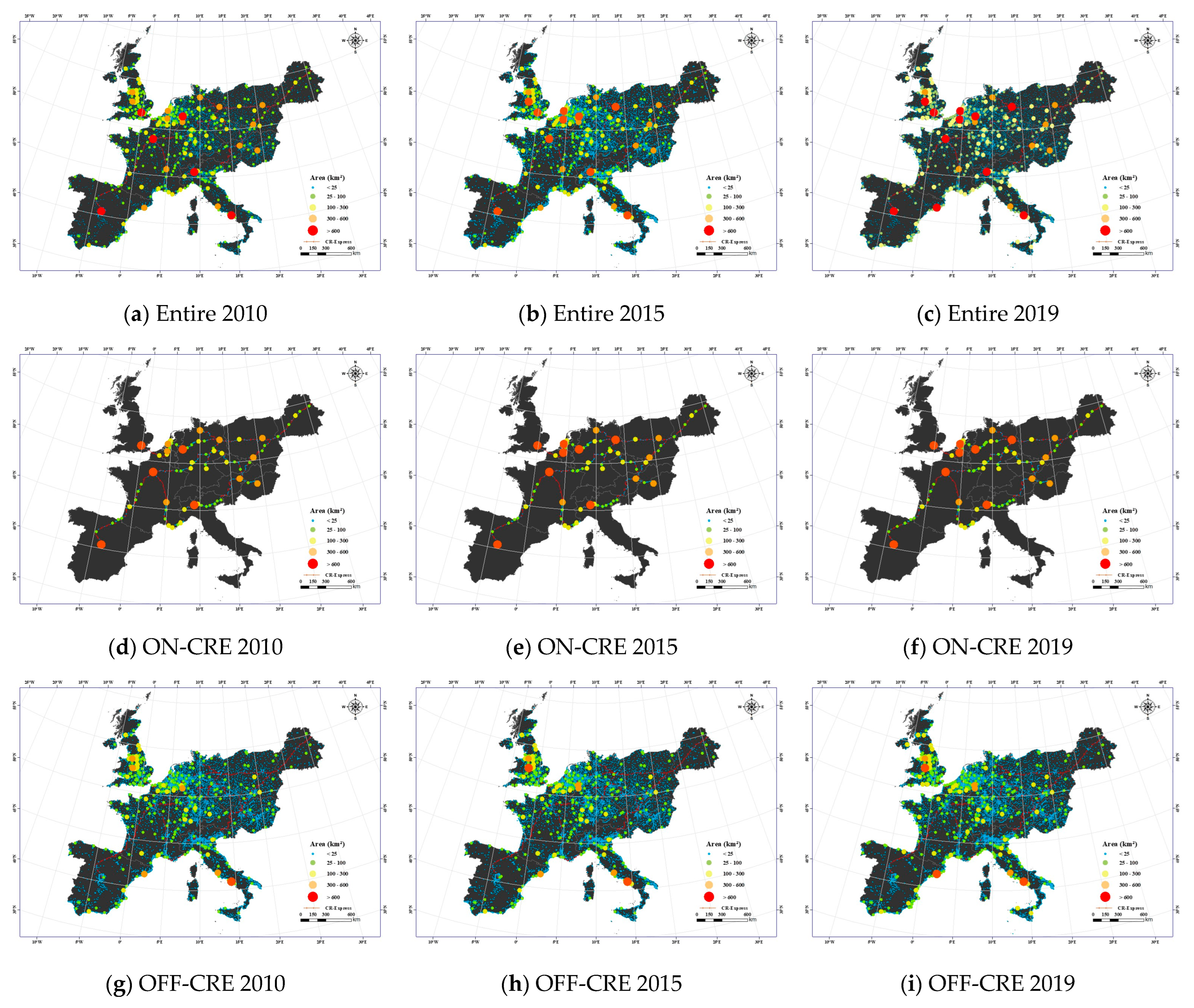
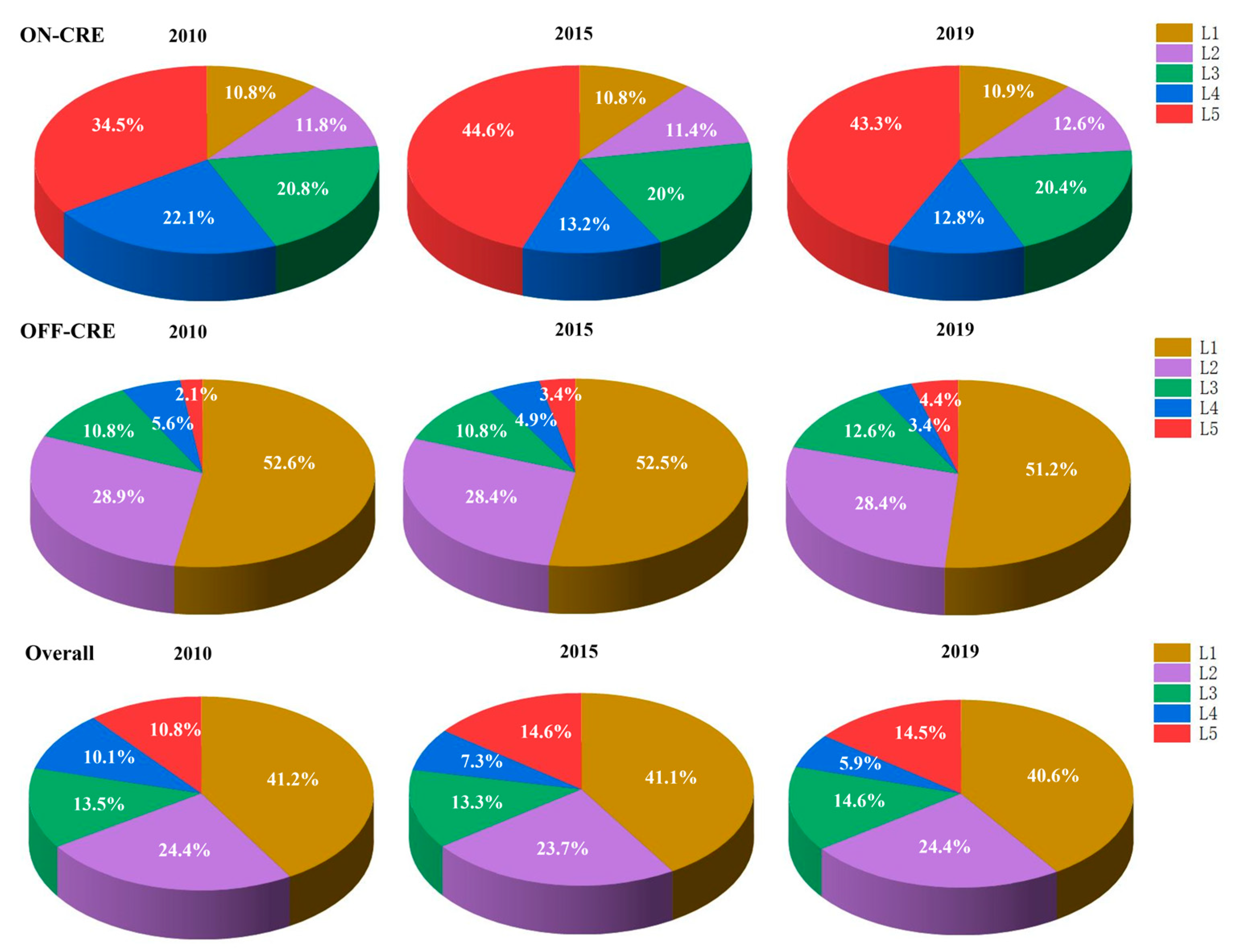
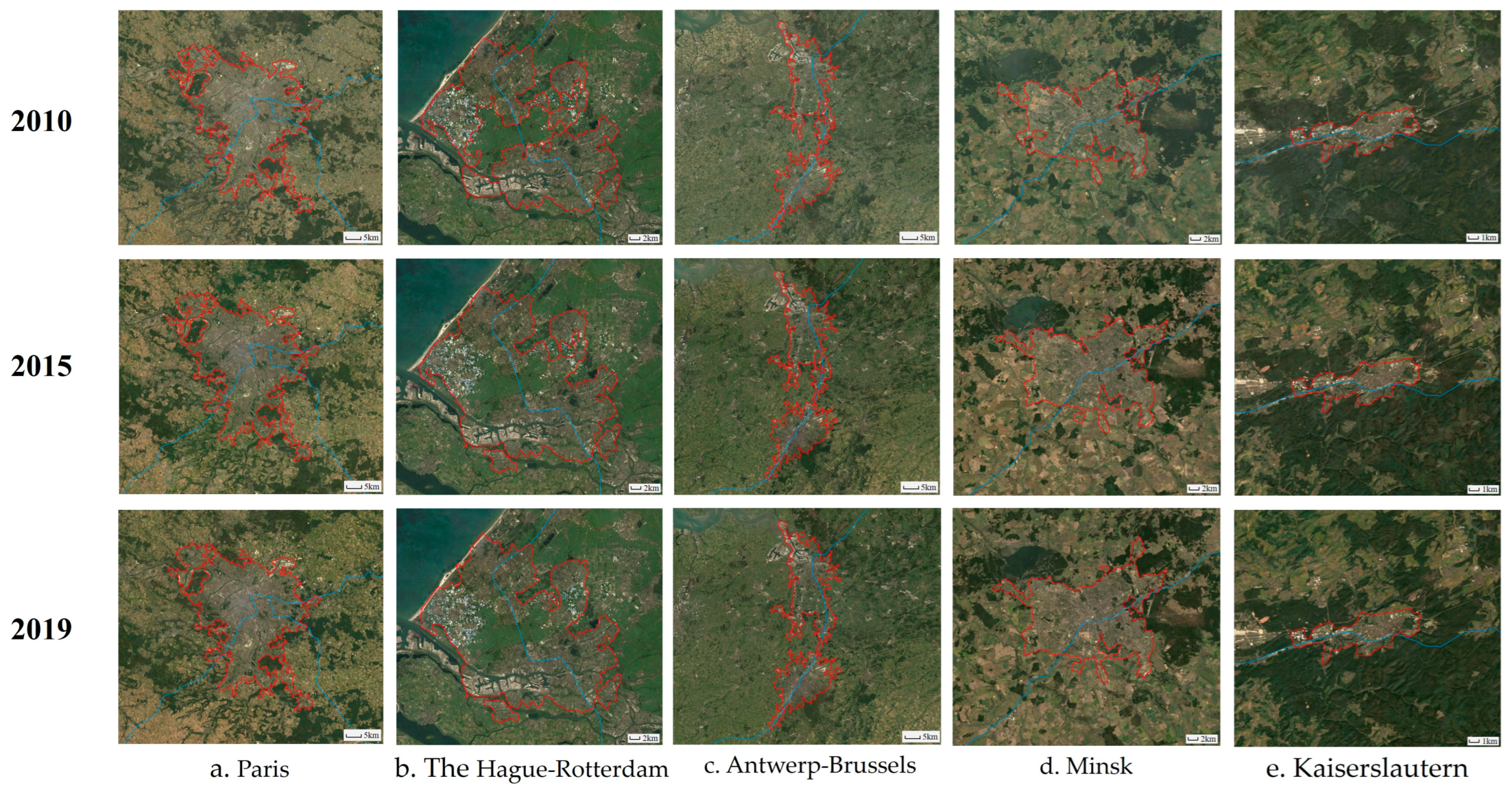
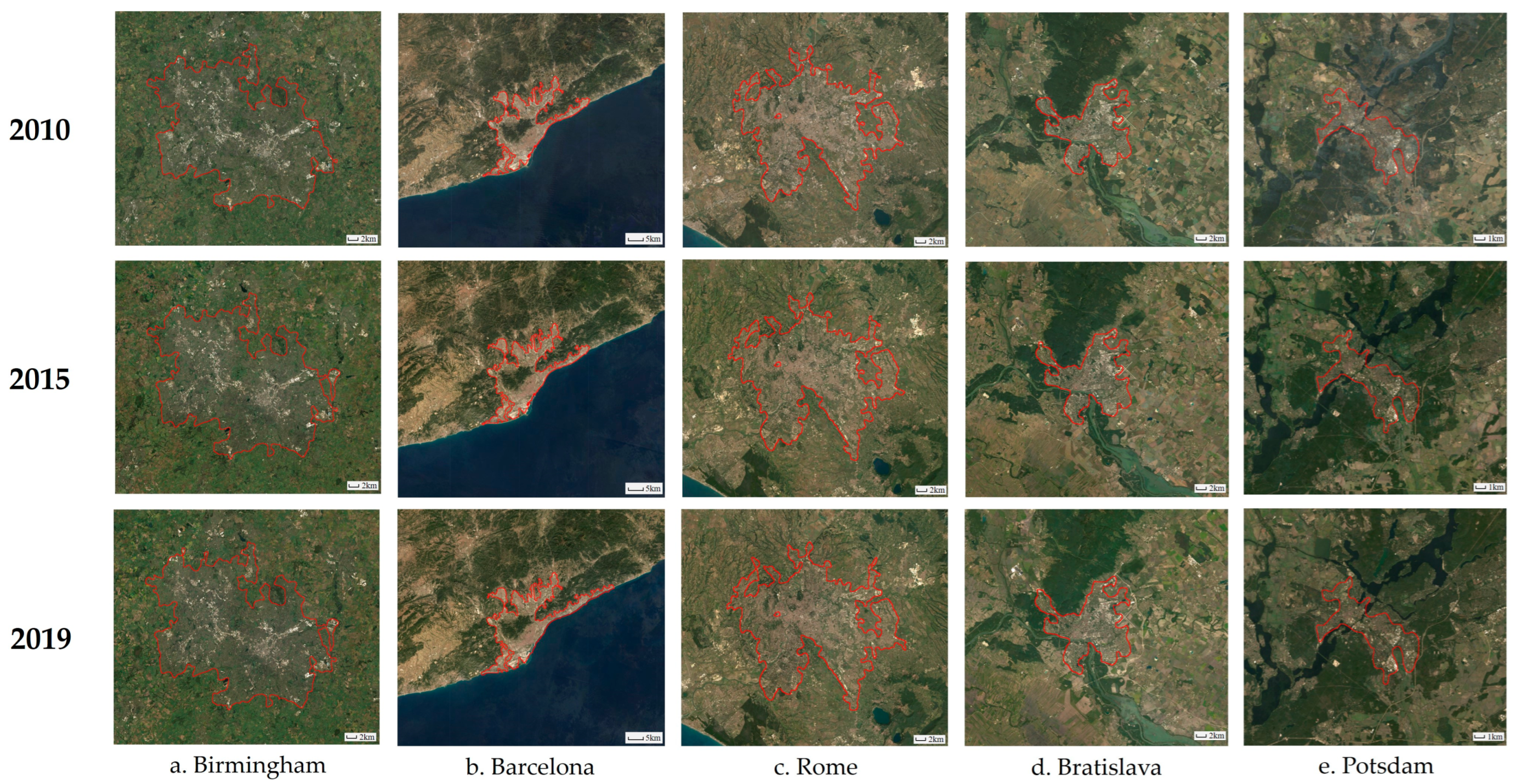
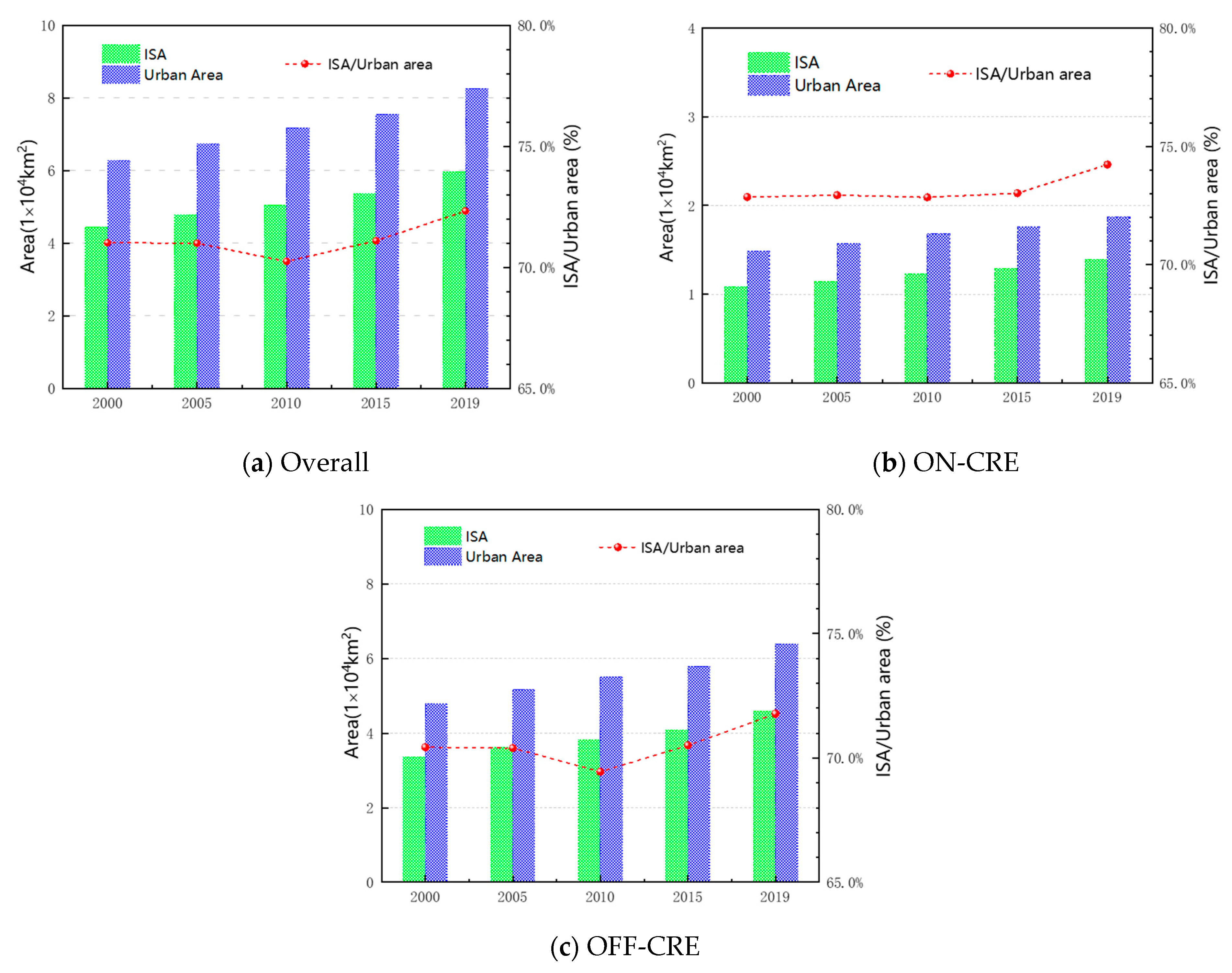
| (1) 18 Countries and Regions along the Express | (2) 19 Countries and Regions Not along the Express |
|---|---|
| Austria, Belarus, Belgium, Czech Republic, France, Germany, Hungary, Italy, Latvia, Lithuania, Luxembourg, Monaco, Netherlands, Poland, Serbia, Slovakia, Spain, United Kingdom. | Albania, Andorra, Bosnia and Herzegovina, Bulgaria, Croatia, Denmark, Estonia, Greece, Ireland, Liechtenstein, Moldova, Montenegro, North Macedonia, Portugal, Romania, San Marino, Slovenia, Switzerland, Vatican City. |
| Entire Study Area | ||||||
|---|---|---|---|---|---|---|
| Area (number) | L1 | L2 | L3 | L4 | L5 | Total |
| 2010 | 25,513.4 (3547) | 14,969.0 (334) | 8300.4 (50) | 6186.2 (14) | 6650.3 (6) | 61,619.4 (3951) |
| 2015 | 26,258.2 (3620) | 15,157.4 (331) | 8497.6 (51) | 4566.8 (11) | 9333.3 (10) | 63,813.4 (4023) |
| 2019 | 28,811.8 (3973) | 17,284.5 (376) | 10,386.1(63) | 4184.4 (10) | 10,287.6 (11) | 70,954.4 (4433) |
| ON-CRE | ||||||
| Area (number) | L1 | L2 | L3 | L4 | L5 | Total |
| 2010 | 1791.3 (218) | 1956.2 (42) | 3437.8 (18) | 3650.1 (9) | 5699.1 (5) | 16,534.5 (292) |
| 2015 | 1874.8 (225) | 1971.4 (42) | 3478.2 (18) | 2278.9 (6) | 7745.9 (8) | 17,349.2 (299) |
| 2019 | 1998.5 (233) | 2319.7 (47) | 3754.6 (18) | 2359.0 (6) | 7956.2 (8) | 18,387.9 (312) |
| OFF-CRE | ||||||
| Area (number) | L1 | L2 | L3 | L4 | L5 | Total |
| 2010 | 23,722.1 (3329) | 13,012.9 (292) | 4862.5 (32) | 2536.1 (5) | 951.2 (1) | 45,084.8 (3659) |
| 2015 | 24,383.4 (3395) | 13,186.0 (289) | 5019.4 (33) | 2288.0 (5) | 1587.4 (2) | 46,464.2 (3724) |
| 2019 | 27,026.5 (3769) | 14,962.8 (329) | 6627.6 (45) | 1797.6 (4) | 2331.4 (3) | 52,746.0 (4150) |
| Paris | The Hague–Rotterdam | Antwerp– Brussels | Minsk | Kaiserslautern | |
|---|---|---|---|---|---|
| Population (m) | 2.2 | 1.7 | 2.8 | 2.0 | 0.1 |
| Area (2010, km2) | 1474.63 | 498.65 | 660.11 | 230.16 | 24.63 |
| Area (2015, km2) | 1501.6 | 624.95 | 683.85 | 253.98 | 26.11 |
| Area (2019, km2) | 1540.27 | 647.269 | 711.5 | 274.18 | 27.04 |
| Expansion rates (2010–2015) | 1.83% | 25.33% | 3.60% | 10.35% | 6.03% |
| Expansion rates (2015–2019) | 2.58% | 3.57% | 4.04% | 7.95% | 3.57% |
| Birmingham | Barcelona | Rome | Bratislava | Potsdam | |
|---|---|---|---|---|---|
| Population (m) | 2.6 | 5.5 | 4.2 | 0.4 | 0.2 |
| Area (2010, km2) | 593.51 | 576.64 | 383.07 | 98.02 | 24.46 |
| Area (2015, km2) | 603.53 | 586.47 | 395.04 | 99.87 | 25.53 |
| Area (2019, km2) | 607.22 | 649.74 | 404.43 | 101.85 | 26.93 |
| Expansion rates (2010–2015) | 1.69% | 1.71% | 3.12% | 1.89% | 4.36% |
| Expansion rates (2015–2019) | 0.61% | 3.57% | 2.38% | 1.98% | 5.48% |
Disclaimer/Publisher’s Note: The statements, opinions and data contained in all publications are solely those of the individual author(s) and contributor(s) and not of MDPI and/or the editor(s). MDPI and/or the editor(s) disclaim responsibility for any injury to people or property resulting from any ideas, methods, instructions or products referred to in the content. |
© 2024 by the authors. Licensee MDPI, Basel, Switzerland. This article is an open access article distributed under the terms and conditions of the Creative Commons Attribution (CC BY) license (https://creativecommons.org/licenses/by/4.0/).
Share and Cite
Guo, X.; Pei, Y.; Xu, H.; Wang, Y. Mapping Urban Expansions along China–Europe Railway Express with the 30 m Time-Series Global Impervious Surface Area (GISA-2) Data from 2010 to 2019. Sustainability 2024, 16, 1651. https://doi.org/10.3390/su16041651
Guo X, Pei Y, Xu H, Wang Y. Mapping Urban Expansions along China–Europe Railway Express with the 30 m Time-Series Global Impervious Surface Area (GISA-2) Data from 2010 to 2019. Sustainability. 2024; 16(4):1651. https://doi.org/10.3390/su16041651
Chicago/Turabian StyleGuo, Xian, Yujie Pei, Hong Xu, and Yang Wang. 2024. "Mapping Urban Expansions along China–Europe Railway Express with the 30 m Time-Series Global Impervious Surface Area (GISA-2) Data from 2010 to 2019" Sustainability 16, no. 4: 1651. https://doi.org/10.3390/su16041651





